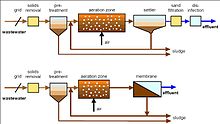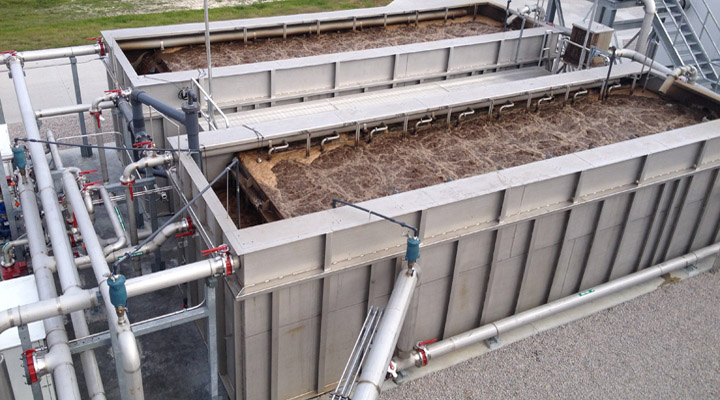Exactly How Membrane Bioreactors Are Changing Water Filtration Equipments
The development of membrane bioreactors (MBRs) represents a considerable innovation in the area of water purification, combining organic therapy processes with advanced membrane layer filtration modern technologies. As worldwide water shortage escalates, the duty of MBRs in promoting drinkable water reuse and lasting water management ends up being significantly crucial.
Introduction of Membrane Layer Bioreactors
Membrane bioreactors (MBRs) represent a substantial innovation in water purification modern technology, as they combine biological therapy processes with membrane purification. This combination enhances the performance of wastewater therapy by using bacteria to deteriorate organic toxins while concurrently employing semi-permeable membranes to separate cured water from suspended solids and pathogens.
The MBR system normally includes an organic reactor where the microbial population metabolizes impurities, complied with by a membrane layer purification unit that keeps biomass and allows only clean water to go through. This dual capability causes higher effluent top quality contrasted to conventional treatment methods. MBRs can be operated in both set and continuous circulation settings, supplying versatility in style and application.
Additionally, MBRs are identified by their small impact, making them appropriate for metropolitan setups with room constraints. Membrane Bioreactor. They additionally allow the recuperation of water for reuse, thus adding to water sustainability initiatives. While MBR innovation has obtained appeal in municipal and industrial applications, its operational complexities and energy demands necessitate mindful consideration during execution. Generally, MBRs go to the center of boosting water therapy effectiveness and quality, showcasing the capacity for innovative remedies in ecological administration.
Benefits of MBR Technology
The assimilation of organic therapy with membrane purification provides numerous advantages for water purification processes. One of the main advantages of Membrane layer Bioreactor (MBR) innovation is its ability to successfully eliminate both not natural and organic contaminants, causing top quality effluent. The membranes work as a physical obstacle, protecting against put on hold solids and virus from going through, which boosts the total safety and security and dependability of cured water.
Additionally, MBR systems need a smaller impact compared to conventional therapy techniques, enabling for a lot more effective room usage. This compact style is especially useful in urban settings where land is restricted. MBRs also show functional flexibility, accommodating differing influent top qualities and flow prices without substantial efficiency degradation.
Additionally, the process uses improved nutrient removal capacities, specifically for nitrogen and phosphorus, which are vital for preventing eutrophication in receiving waters. The reduced sludge manufacturing linked with MBR modern technology likewise translates to reduce disposal costs, making it a cost-effective service in the long run - Membrane Bioreactor. On the whole, the advantages of MBR modern technology position it as a leading selection for innovative and sustainable water filtration systems, addressing both ecological and financial concerns
Applications in Water Purification
Applications of Membrane Bioreactor (MBR) innovation in water purification are impactful and diverse, attending to various treatment requires across numerous industries. MBRs efficiently integrate organic treatment processes with membrane filtration, making them excellent for metropolitan wastewater therapy, commercial effluent monitoring, and even drinkable water reuse campaigns.
In community setups, MBRs are progressively utilized to enhance the high quality of dealt with wastewater, allowing for conformity with rigorous discharge policies and helping with the recycling of water for watering and non-potable uses. Their portable style also makes them ideal for metropolitan settings where area is restricted.
Industrially, MBR innovation is used to deal with process water and wastewater, specifically in sectors such as food and drink, drugs, and fabrics. By efficiently eliminating pollutants and put on hold solids, MBRs assist sectors minimize ecological impacts while recovering important resources from wastewater streams.
Additionally, MBRs are getting grip in decentralized water therapy applications, where small-scale systems can be deployed in remote locations or creating regions. This flexibility enables neighborhoods to achieve lasting water monitoring remedies, boosting accessibility to tidy water while reducing dependence on traditional treatment approaches.
Study and Success Stories

In another example, a textile production facility in Bangladesh embraced MBR modern technology to resolve its wastewater challenges. The system decreased chemical oxygen need (COD) degrees from 1,200 mg/L to less than 100 mg/L, hence satisfying regulatory standards and significantly reducing ecological effect.
The College of Cape Town's MBR setup has actually proven efficient in dealing with greywater for non-potable reuse on school. This project not only preserves potable water but likewise acts as an instructional design for lasting methods.
In addition, a fish and shellfish processing plant in Norway made use of MBR innovation to treat effluents including high degrees of natural matter, achieving over 90% contaminant removal. These study emphasize MBR modern technology's flexibility and its essential duty in enhancing water high quality throughout varied applications.
Future of Water Treatment Solutions
As global water scarcity and pollution challenges escalate, cutting-edge water treatment solutions are ending up being significantly crucial to make sure sustainable access to tidy water. The future of water treatment exists in the integration of sophisticated technologies that enhance the efficiency and performance of purification procedures. Membrane layer bioreactors (MBRs) are at the leading edge of this development, integrating organic treatment with membrane filtering to produce high-grade effluent appropriate for different applications.

Emerging fads such as source healing from wastewater, consisting of nutrients and power, will further change therapy facilities right into environment-friendly centers. Innovations in nanotechnology and membrane materials guarantee boosted efficiency and durability of purification systems.

Final Thought
Finally, membrane bioreactors represent a considerable advancement in water purification innovations, properly combining biological therapy with sophisticated membrane filtration. The many benefits, consisting of enhanced effluent quality and lowered spatial requirements, make MBRs specifically suitable for city applications. Their role in drinkable water reuse and sustainable water management highlights their relevance in addressing worldwide water scarcity obstacles. Proceeded r & see here d will certainly even more enhance the efficiency and fostering of MBR modern technology, guaranteeing a resilient future for water therapy options.
The appearance of membrane layer bioreactors (MBRs) represents a considerable advancement in the field of water purification, combining biological therapy procedures with sophisticated membrane purification innovations. As worldwide water deficiency intensifies, the role of MBRs in facilitating safe and clean water reuse and sustainable water management ends up being progressively important. They additionally allow the recuperation of water for reuse, hence adding to water sustainability initiatives.As international water shortage and air pollution challenges intensify, innovative water treatment solutions are ending up being increasingly important to ensure sustainable access to tidy water. Their role in potable water reuse and lasting water management highlights their importance in addressing international water deficiency challenges.